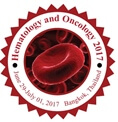Patrick Van Dreden
Sorbonne Universities, France
Title: Determinant role of procoagulant microparticles derived from cancer cells in the hypercoagulable state associated with cancer
Biography
Biography: Patrick Van Dreden
Abstract
Introduction: The hypercoagulable state of malignancy occurs due to the ability of tumor cells to activate the coagulation system. The prominent role is attributed to exposure of tissue factor (TF) and procoagulant phospholipids (PPL) by the tumor cell. We recently showed that contact of human plasma with pancreas adenocarcinoma cells (BXPC3) or breast cancer cells (MCF7) enhances thrombin generation (TG). We demonstrated that the procoagulant activity of the cancer cells alone was not sufficient to induce hypercoagulability We analyzed the specific procoagulant role of microparticles (MVs) originate from the cancer cells and we estimated their association with cancer cells for cancer induced hypercoagulability
Methods: BXCP3 and MCF7 cells were culturedin 96-well plates.Primary human umbilical vein cells (HUVEC) were used as normal control experiment. The CAT® assay (Stago France) was used to study TG of normal platelet poor plasma added in wells carrying (a) cancer cells, (b) cancer cells in presence of their respectively isolated MVs, or (c) MVs alone.TF activity (TFa) of cells and MVs was assessed with a specific clotting assay.
Results: The TFa were found in abundant amounts BXPC3 cells, and BXPC3 MVs compared to MCF7 cells and MCF7 MVs. The HUVEC cells and HUVEC MVs showed TF activity comparable to a normal pool. Analytical data of TG are depicted in Table 1
|
|
Thrombin generation on cells ± MVs with MP reagent in Normal Pool plasma ( no TF/PPL 4µM) |
||||||||
|
Pool |
HUVEC |
BXPC3 |
MCF7 |
HUVEC +MVs |
BXPC3 +MVs |
MCF7 +MVs |
Pool +MVs(BXPC3) |
Pool +MVs(MCF7) |
|
|
Lag-time (min) |
8.9±1.6 |
7.7±0.9 |
4.8±0.6 |
7.5±0.7 |
7.9±0.9 |
1.2±0.5 |
5.1±0.7 |
2.2±0.6 |
6.1±0.4 |
|
tt-Peak (min) |
14.6±1.3 |
12.1±0.9 |
5.7±0.8 |
9.3±1.0 |
11.7±0.9 |
2.6±0.6 |
6.9±1.1 |
3.3±0.4 |
8.2±0.8 |
|
Peak (nM) |
136±11 |
150±11 |
220±12 |
179±11 |
166±10 |
410±12 |
220±10 |
380±14 |
210±11 |
|
MRI (nM/min) |
24±9 |
35±10 |
244±13 |
99±12 |
45±10 |
294±11 |
120±12 |
247±14 |
100±13 |
Table1: Thrombin generation on cells in presence and absence of MVs in normal pool Plasma
Conclusions: This experiment showed that hypercoagulability induced by cancer cells is the resultant of the combination of the procoagulant properties of cancer cells with procoagulant elements of the plasma microenvironment. To the best of our knowledge, the present study showed for the first time that the inherent procoagulant properties of cancer cells are not sufficient to induce hypercoagulability and documents that procoagulant elements of the microenvironment, namely MVs are necessary elements for cancer induced hypercoagulability.

